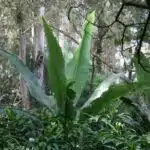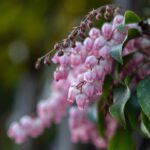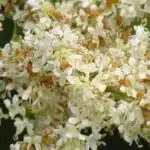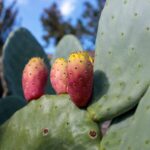The Japanese Banana, also known as Musa Basjoo, is a tropical plant that has been gaining popularity among horticulturists around the world. This species of banana is native to Japan and China and is widely grown in gardens and landscapes due to its hardiness and tolerance to cold temperatures. As a horticulturist specializing in the cultivation of Japanese Bananas, I have dedicated my career to studying this unique plant’s growing conditions, propagation techniques, and pest management practices.
Growing Japanese Bananas can be a rewarding experience for both amateur and experienced gardeners alike. However, it requires proper planning and care to ensure successful growth. In this article, I will provide a comprehensive guide on how to care for and grow Japanese Bananas successfully. From selecting the right location for planting to managing pests and diseases, this guide will equip you with all the knowledge necessary to cultivate healthy Japanese Banana plants. Whether you are interested in growing these bananas for personal consumption or purely aesthetic purposes, this guide will serve as an invaluable resource for your gardening journey.
History And Origin Of Musa Basjoo
The Musa Basjoo, also known as the Japanese Banana, is a stunning plant that has captured the attention of horticulturists all over the world. This plant is not only beautiful but also very resilient, making it an ideal addition to any garden or landscape. The history and origin of this plant are both fascinating and culturally significant.
The Musa Basjoo originated in Japan, where it was first discovered in the early 19th century. It quickly became popular due to its hardiness and adaptability to various climates. Despite its popularity, cultivating the Japanese Banana comes with its own set of challenges. This plant is sensitive to frost and requires a warm environment to thrive.
Despite these challenges, the cultural significance of the Musa Basjoo cannot be overlooked. It has become an important symbol in Japanese culture, representing resilience and perseverance. As horticulturists continue to cultivate this plant worldwide, they contribute to preserving this cultural legacy for generations to come.
As we move into discussing the characteristics of the Japanese Banana, it is important to note that this resilient plant has much more than just cultural significance. Its unique characteristics make it a standout among other banana plants worldwide.
Characteristics Of Japanese Bananas
- Japanese bananas (Musa basjoo) are known for their large leaves, which can reach up to 5 feet in length.
- The stems of Japanese bananas are exceptionally thick, with a diameter of up to 8 inches.
- The fruit of Japanese bananas is a typical yellow color and can reach up to 8 inches in length.
- Japanese bananas have a very high rate of fruiting and can produce up to 200 fruits each season.
- The flowers of Japanese bananas are small and white and have a bell-shaped form.
- Japanese bananas have a very high tolerance for cold temperatures, and are often seen growing in areas with temperatures as low as -10°C.
Large Leaves
As a horticulturist specializing in Japanese bananas, I have observed that one of the most striking characteristics of this plant is its large leaves. These leaves can grow up to 3 meters long and 1 meter wide, making them one of the largest leaf sizes seen in the plant world. The shape of the leaves is also unique, with a broad paddle-like structure that tapers to a pointed tip.
It is important to note that the size and shape of the leaves are not just for aesthetics – they serve an important purpose in the growth and development of the plant. The large surface area of the leaves allows for maximum sunlight absorption, which is crucial for photosynthesis and healthy growth. Additionally, the shape of the leaves helps to channel rainwater down towards the root system, ensuring adequate hydration.
To care for these impressive leaves, it is essential to provide ample space for them to grow without being obstructed by other plants or structures. A well-draining soil mix rich in nutrients will also help support healthy leaf growth. As with any plant, regular watering and fertilization are key to maintaining optimal health and vitality. With proper care and attention, your Japanese banana plant’s large leaves will continue to impress and serve as a stunning addition to your garden or indoor space.
Thick Stem
As a horticulturist specializing in Japanese bananas, I have observed that this plant possesses several unique characteristics that make it stand out from other plants. We previously discussed the large size and unique shape of its leaves, which play a vital role in the plant’s growth and development. Another notable characteristic of Japanese bananas is their thick stem, which provides structural support to the entire plant.
The thick stem of Japanese bananas serves as the backbone of the plant, holding up its large leaves and ensuring that it remains upright. This structural support is crucial for healthy growth and development, especially as the plant matures and becomes heavier. In addition to providing stability, the thick stem also impacts the overall growth of the plant by allowing it to store nutrients and water for longer periods.
To care for Japanese banana plants with thick stems, it is important to provide adequate support through staking or tying if necessary. A well-draining soil mix rich in nutrients will help promote healthy stem growth and development. Additionally, regular fertilization will ensure that the plant has access to all of the necessary nutrients it needs to thrive. With proper care and attention, your Japanese banana plant’s thick stem will continue to provide essential structural support throughout its life cycle.
Yellow Fruit
As a horticulturist specializing in Japanese bananas, I am fascinated by the various characteristics of this unique plant. In addition to its large leaves and thick stem, another notable feature of Japanese bananas is their yellow fruit. The yellow fruit of Japanese bananas is an essential aspect that contributes to the overall appeal and value of this plant.
Japanese bananas are known for producing sweet and delicious fruit that can be used in a variety of banana recipes. From smoothies to baked goods, yellow fruits from Japanese bananas add a distinct flavor and texture to any dish. Aside from its culinary uses, consuming Japanese bananas also provides numerous health benefits such as improving digestion, boosting energy levels, and promoting heart health.
To ensure the production of healthy and high-quality yellow fruit in Japanese banana plants, proper care is crucial. This includes providing sufficient water, fertilization, and appropriate pruning techniques. With these practices in place, the yellow fruit produced by Japanese banana plants will continue to provide both culinary delights and health benefits for years to come.
Climate And Soil Requirements
The Japanese banana, also known as Musa basjoo, is a tropical plant that thrives in warm climates. It can grow well in USDA zones 5 to 10, with temperature tolerance ranging from -20°F to 90°F. The ideal temperature range for growth and fruit production is between 75°F to 85°F. When the temperature drops below 50°F, the plant goes dormant and requires protection from frost.
Soil composition plays a crucial role in the successful growth of Japanese bananas. The soil should be well-draining, loose and fertile, with a pH range of 6.0 to 7.0. Sandy loam soil is ideal for this plant as it provides excellent drainage while retaining enough moisture for healthy growth. Adding organic matter such as compost or manure can improve soil fertility and structure.
To ensure optimal growth of the Japanese banana, it’s essential to provide suitable growing conditions that mimic its natural habitat. Here are some tips for creating the perfect environment:
- Choose a location that receives full sun exposure for at least six hours a day.
- Plant the banana in an area protected from strong winds that can damage leaves and stems.
- Provide regular watering, making sure not to over-water as this can result in root rot.
Choosing the right location for planting is crucial for ensuring successful growth of Japanese bananas. By paying attention to climate and soil requirements, you can create an environment where your plant will thrive and produce beautiful fruit year after year.
Choosing The Right Location For Planting
The success of growing Japanese bananas largely depends on the location where they will be planted. As a horticulturist, I recommend choosing a site that receives full sun exposure for most of the day. While these plants can tolerate partial shade, they thrive best with at least six hours of sunlight daily. This enables optimal growth and encourages the plant to produce flowers and fruit.
In addition to sun exposure, soil type is also crucial in determining the health and growth rate of Japanese banana plants. These plants prefer well-draining soil that is rich in organic matter. This helps prevent waterlogging and root rot, which are common issues associated with poor drainage. A pH level between 5.5-7.0 is ideal for healthy plant development.
Spacing and drainage are also key factors to consider when selecting a planting location for Japanese bananas. It’s important to space each plant adequately to allow enough room for proper air circulation and sunlight penetration between plants. Additionally, planting in an area with good drainage will help prevent water accumulation around the roots, which can lead to root rot or other diseases.
Now that we have discussed how to choose the right location for your Japanese banana plants, it’s time to move onto planting and propagation techniques. By following proper guidelines and taking care during this stage, you can ensure successful growth and fruit production from your plants.
Planting And Propagation Techniques
After selecting the appropriate location for planting a Japanese banana plant, it is essential to prepare the soil adequately. The soil should have good drainage and be rich in organic matter. We recommend digging a hole that is twice as wide and deep as the root ball of the plant. Mix compost or well-rotted manure with the soil and fill the hole halfway.
Propagation techniques for Japanese banana plants are relatively straightforward. They can be propagated by seed, division, or suckers. However, propagation by suckers is the most common method used by gardeners because it produces quicker results. Suckers are young shoots that grow from underground rhizomes of established plants. When they are about two feet tall, they can be separated from their parent plant and replanted in a new location.
After preparing the soil and deciding on propagation techniques, it’s time to plant your Japanese banana plant. Gently remove the plant from its container and place it in the center of the hole you prepared earlier. Fill up to ground level with soil mixed with organic matter and water thoroughly to settle it in place. Finally, mulch around the base of your newly planted shrub to retain moisture in the soil and suppress weed growth.
As important as planting and propagation techniques are for growing healthy Japanese banana plants, watering and fertilization are equally crucial aspects of care that must not be overlooked. In this next section, we will discuss how much water these tropical plants require and what kind of fertilizer they need to prosper throughout their life cycle.
Watering And Fertilization
Watering frequency is a crucial aspect of the Japanese banana plant’s care. Over-watering can cause root rot and stunted growth, while under-watering can lead to drooping leaves and wilting. It is recommended to water the plant once a week, allowing the soil to dry out slightly between waterings. During hot summer months, the plant may require more frequent watering to prevent dehydration.
Fertilizer types also play an important role in the growth and health of the Japanese banana plant. A balanced fertilizer with equal amounts of nitrogen, phosphorus, and potassium should be used every two weeks during the growing season. In addition to this, adding organic matter such as compost or manure to the soil can provide essential nutrients for optimal growth.
To ensure proper pruning and maintenance of your Japanese banana plant, it is essential to monitor its growth regularly. Pruning should be done in late winter or early spring before new growth begins. Remove any dead or damaged leaves and stems, as well as any suckers that emerge from the base of the plant. Regularly checking for pests and diseases is also vital for maintaining a healthy plant. Treating any issues promptly can prevent them from spreading and causing damage to the entire plant.
Pruning And Maintenance
- Pruning is a critical aspect of Japanese banana plant care, as it helps to maintain the health and vigor of the plant.
- Pruning basics include selecting the right tools, as well as understanding the growth habits and needs of the plant.
- Pruning techniques vary depending on the desired shape and size of the plant, as well as the season and growth stage of the plant.
- Careful and precise pruning will help to ensure healthy new growth, and optimize the overall health of the Japanese banana plant.
Pruning Basics
Pruning is an essential aspect of maintaining the health and growth of Japanese banana plants. Pruning techniques vary depending on the growth patterns of these plants. In general, pruning is done to remove dead, damaged, or diseased parts of the plant to encourage new growth.
For Japanese banana plants, pruning should be done in late winter or early spring before new growth begins. One effective technique is to remove any suckers growing from the base of the plant, as they can compete with the main stem for nutrients and water. It is also important to prune any old or damaged leaves, as they can harbor pests and diseases.
Another key aspect of pruning Japanese banana plants is to thin out excess growth. This includes removing any side shoots that are growing too close together or crowding each other out. By doing so, the plant will have more room to grow and produce healthy fruit. Proper pruning techniques can not only enhance the appearance of Japanese banana plants but also ensure their longevity and productivity.
Pruning Techniques
Pruning and maintenance are critical aspects of Japanese banana plant cultivation. These plants require regular pruning to ensure optimal growth and productivity. Pruning frequency should be determined based on the growth patterns of the plants. For Japanese banana plants, it is recommended to prune during late winter or early spring before new growth begins.
Pruning techniques for Japanese banana plants involve the use of various tools such as pruning shears, loppers, and saws. The choice of tool depends on the thickness of the branch being pruned. It is essential to use sharp, clean tools to avoid damaging the plant and spreading diseases. When pruning, it is crucial to make clean cuts close to the main stem or branch collar, leaving no stubs that can attract pests or diseases.
The goal of pruning techniques is to remove dead, damaged, or diseased parts of the plant while encouraging new growth. Thinning out excess growth is also an essential aspect of pruning Japanese banana plants. This involves removing any side shoots that are growing too close together or crowding each other out. Proper pruning techniques can not only enhance the appearance of Japanese banana plants but also ensure their longevity and productivity, leading to a successful harvest season after season.
Managing Pests And Diseases
As a horticulturist, it is important to keep in mind that pests and diseases can cause significant damage to Japanese banana plants. To prevent such occurrences, we recommend taking preventative measures such as maintaining proper hygiene by removing any dead or diseased plant material. Additionally, regularly inspecting the leaves for any signs of pest infestation or disease can help detect problems early on and allow for immediate action.
If pests or diseases are detected, natural remedies should be used whenever possible. For instance, spraying a mixture of water and neem oil on the affected areas can help control aphids and other insects. Copper fungicides can also be applied to prevent the spread of fungal diseases. However, it is important to note that these remedies should be used sparingly as they may harm beneficial insects.
In some cases, pests or diseases may require more aggressive treatment such as chemical pesticides. When using chemical pesticides, it is essential to follow the instructions carefully and apply them only when necessary. It is important to emphasize that prevention is always better than cure when it comes to managing pests and diseases in Japanese banana plants.
- Regularly check leaves for signs of infestation or disease.
- Use natural remedies such as neem oil or copper fungicides.
- Minimize the use of chemical pesticides.
- Maintain proper hygiene by removing dead or diseased plant material.
As horticulturists, our primary goal is to serve our customers by providing healthy and productive plants. By following these preventative measures and utilizing natural remedies whenever possible, we can ensure that Japanese banana plants remain healthy and free from pests and diseases.
Transition:
Now that we have discussed how to manage pests and diseases in Japanese banana plants let’s move on to the next crucial step – harvesting and storage techniques for optimal fruit quality.
Harvesting And Storage
Managing pests and diseases is crucial to maintaining the health of your Japanese banana plant. However, once you have successfully dealt with these issues, it is time to focus on the next step: harvesting and storage. Knowing when your bananas are ripe is essential for ensuring that you get the best flavor and texture from your fruit.
When it comes to determining banana ripeness, it is important to monitor the color of the fruit. Japanese bananas typically start out green but will gradually turn yellow as they ripen. You can also check for ripeness by gently squeezing the fruit; if it yields slightly under pressure, then it is ready to harvest. It’s important not to wait too long before harvesting, as overripe bananas can quickly become mushy and unappetizing.
Once you’ve harvested your Japanese bananas, there are several preserving techniques you can use to prolong their shelf life. One option is to store them in a cool, dry place such as a pantry or cellar. Another method is to freeze them; simply peel the bananas and place them in a freezer-safe container before storing them in your freezer. Alternatively, you can use dehydrating techniques such as air-drying or using a food dehydrator.
In summary, harvesting and storing Japanese bananas requires careful attention to detail in order to ensure maximum flavor and longevity. By monitoring banana ripeness and using appropriate preserving techniques such as freezing or drying, you can enjoy your banana crop for weeks or even months after harvest. In the next section, we will explore some common varieties of Japanese bananas that are popular among horticulturists around the world.
Common Varieties Of Japanese Bananas
Japanese bananas are a popular fruit variety among horticulturists and banana enthusiasts. They come in different varieties, each with distinct characteristics that make them unique. The growing season for Japanese bananas varies depending on the variety, but generally, they grow best during the warm months of summer.
One of the most notable features of Japanese bananas is their high nutritional value. These fruits are rich in vitamins and minerals such as potassium, vitamin C, and dietary fiber. They also contain antioxidants that help protect the body from harmful free radicals. Incorporating Japanese bananas into your diet can be an excellent way to maintain good health.
When it comes to growing Japanese bananas, it’s essential to choose the right variety for your climate and location. Some varieties may not thrive in certain regions due to temperature or soil conditions. However, with proper care and attention, you can cultivate healthy banana plants that produce delicious fruits throughout the growing season.
As a horticulturist specializing in Japanese bananas, it’s crucial to understand the nutritional value and growing requirements of each variety. By selecting the appropriate cultivar for your area and providing optimal growing conditions, you can ensure healthy plant growth and bountiful harvests. In our next section, we will explore some of the culinary uses of Japanese bananas and how you can incorporate them into your dishes to enjoy their delightful flavors while reaping their health benefits.
Culinary Uses Of Japanese Bananas
As a Japanese banana horticulturist, I have seen the versatility of this fruit in various culinary uses. One popular use of the Japanese banana is as a vegan alternative to dairy-based products. The creamy texture and mild flavor make it an excellent substitute for milk or cream in recipes like smoothies, ice cream, and baked goods.
In addition to being a vegan alternative, Japanese bananas are also used in traditional Japanese dishes. One such dish is banana tempura, where slices of ripe banana are coated in tempura batter and fried until crispy. Another popular dish is banana mochi, where mashed bananas are mixed with sticky rice flour and then steamed to create a soft and chewy dessert.
If you’re looking to incorporate Japanese bananas into your cooking, here are some ideas to get you started:
- Blend frozen Japanese bananas with almond milk and vanilla extract for a healthy and delicious ice cream alternative.
- Top your morning oatmeal with sliced fresh Japanese bananas for added sweetness and texture.
- Use mashed Japanese bananas instead of eggs in baking recipes.
- Make a savory stir-fry by combining sliced Japanese bananas with veggies like bell peppers, onions, and mushrooms.
As you can see, there are many ways to enjoy the unique flavor and texture of the Japanese banana in your cooking. However, their uses don’t stop at the kitchen – next we’ll explore how they can add beauty to your landscaping projects.
Landscaping With Japanese Bananas
Japanese bananas are an excellent addition to any landscape design, as they provide a unique and tropical aesthetic that is sure to catch the eye of passersby. When it comes to landscaping with Japanese bananas, there are many creative ideas that can be implemented to make your space stand out.
One of the most popular uses for Japanese bananas in landscaping is as a focal point. Planting them in a central location within your garden or yard will draw attention and create a stunning visual display. They can also be used to create borders or hedges, adding height and texture to your landscape design.
Another creative use for banana leaves is as natural mulch. Simply chop up the leaves and spread them over your garden bed for an organic, nutrient-rich soil amendment. The leaves will break down over time, releasing their nutrients into the soil while also suppressing weed growth.
With its unique appearance and versatile uses, the Japanese banana is a must-have for any landscape architect looking to add an exotic touch to their designs. Keep reading for answers to some frequently asked questions about Japanese bananas!
Frequently Asked Questions About Japanese Bananas
Landscaping with Japanese Bananas can create a stunning and exotic atmosphere in any garden or backyard. These plants are not only visually pleasing but also provide shade and a tropical feel to the area. With proper Banana Cultivation, Growing Techniques, these plants can thrive in various environments.
To ensure optimal growth of Japanese Bananas, it is crucial to select a suitable location for planting. These plants prefer soil that is well-draining, rich in organic matter, and slightly acidic. Planting should be done during the spring season or when the soil has warmed up enough for optimal root growth.
When caring for Japanese Bananas, regular watering is essential, especially during dry seasons. It is recommended to water them deeply once a week rather than frequent shallow watering. Fertilizing every two weeks with balanced fertilizer helps promote healthy leaf production and fruit development. Additionally, pruning dead leaves regularly improves airflow within the plant canopy.
For those interested in planting Japanese Bananas, here are four key things to keep in mind: proper soil preparation, appropriate planting time, consistent watering practices, and routine fertilization and pruning. By following these tips and techniques of Banana Cultivation and Growing Techniques, you can enjoy healthy and thriving plants that add an exotic touch to your landscape design. In the next section on Frequently Asked Questions about Japanese Bananas, we will cover common problems that may arise while growing these plants and ways to troubleshoot them effectively.
Troubleshooting Common Problems
Diagnosing foliage issues is an integral part of maintaining healthy Japanese banana plants. Leaves are indicators of the plant’s health, and if they start showing signs of damage, it could be a sign of trouble. One common issue is yellowing leaves, which can be due to overwatering or under-fertilization. On the other hand, brown or black spots could signify fungal or bacterial infections.
Dealing with pests and insects is also crucial in keeping Japanese banana plants healthy. Common pests that affect these plants include scales, spider mites, and aphids. These insects suck sap from the plant, causing damage that results in stunted growth and deformed leaves. To combat these pests, it is essential to use insecticides that are suitable for Japanese bananas.
In summary, it is essential to monitor your Japanese banana plants regularly for signs of foliage issues and pest infestations to maintain their health. Diagnosing problems early on will help prevent them from becoming severe and affecting the overall growth of the plant. By taking proactive measures such as using appropriate insecticides and fertilizers, you can ensure your plants remain healthy and vibrant throughout their lifespan.
| Problem | Possible Cause | Solution |
|---|---|---|
| Yellowing leaves | Overwatering or under-fertilization | Adjust watering schedule or fertilize regularly |
| Brown/Black spots on leaves | Fungal or bacterial infection | Apply fungicide or remove affected leaves |
| Scales, spider mites, aphids | Pest infestation | Use insecticide suitable for Japanese bananas |
Moving forward, understanding how to diagnose foliage issues and deal with pests is only one step towards successful growing and care of Japanese banana plants. In the next section, we will discuss additional tips to ensure your plants thrive throughout their lifespan.
Tips For Successful Growing And Care
After addressing common problems encountered while growing Japanese bananas, it’s time to focus on tips for successful care and growth. One of the most popular ways of growing these bananas is through container gardening. This method allows for better management of soil conditions and drainage, leading to healthier plant growth. It also makes it easier to move the plants indoors during winter or any harsh weather conditions.
Another essential tip for successful growth is choosing pest-resistant strains. Some varieties are more resistant to pests than others, making them easier to care for and less prone to damage. For example, the Musa Basjoo variety is known for its resistance to Japanese beetles and other insects that can harm your plants.
Lastly, regular fertilization is crucial in promoting lush foliage and healthy fruit production. Use organic fertilizers such as compost or manure instead of synthetic chemicals which may harm the plant’s growth in the long run. Additionally, always ensure that you water your plants adequately but avoid overwatering as this can lead to root rot.
By following these tips and being mindful of potential issues, anyone can successfully grow healthy and fruitful Japanese bananas at home. With a little bit of patience and careful attention, you will soon be enjoying delicious homegrown bananas!
Conclusion
The Musa Basjoo, commonly known as the Japanese Banana, is a tropical plant that has become increasingly popular among horticulturists and garden enthusiasts. With its stunning foliage and ability to thrive in various climates, this plant is a great addition to any garden or landscape. Whether you are a seasoned gardener or just starting out, this comprehensive guide will provide you with all the information you need to care for and grow your own Japanese Banana.
To begin with, it is essential to understand the history and origin of the Musa Basjoo. This species of banana originated in Japan and can withstand cold temperatures down to -20 degrees Celsius. Its leaves can grow up to two meters long and 70 centimeters wide, making it an impressive sight in any landscape. In addition, this plant produces small but edible bananas that are similar in taste to other varieties of bananas.
When it comes to planting and propagation techniques, there are several factors to consider. The climate and soil requirements must be taken into account when choosing the right location for planting. It is also important to use proper planting techniques such as watering regularly, fertilizing appropriately, and protecting from pests and diseases.
For those looking to use Japanese Bananas as part of their landscaping projects, there are many creative ways to incorporate them into your design. They make excellent focal points or backdrop plants due to their large size and unique shape. They can also be planted in rows or clusters for an impressive effect.
In conclusion, growing and caring for Japanese Bananas requires attention to detail and care throughout the process. By following the guidelines outlined in this guide, you will be well on your way towards creating a beautiful garden or landscape filled with these stunning tropical plants. Remember that successful growing requires patience, dedication, and attention to detail – but with these tips at hand, you can achieve success in no time!
Image Credits
- “World War II Japanese dollar: ‘Banana money’” by kevin dooley (featured)





























